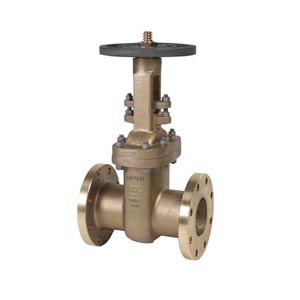Seawater Gate Valves 
A Gate Valve, or Sluice Valve, is operated by turning a handwheel, this handwheel is located on a threaded stem or spindle (Rising or Non Rising) this stem can be located inside or out side (inside / outside screw) the main valve body. This stem connects to a wedge closure device. On operation the wedge is lifted in or out of the path of the fluid (Seawater). When fully open, the gate valve has no obstruction in the flow path
Gate valves should not be used for regulating (throttling) the flow of liquids having been designed to be fully opened or closed.
Bonnets (Covers - top half of the valve) provide leakproof closure for
the valve body. Gate valves bonnets come in many different configurations
some may have
•Screwed Cover / Bonnet
•Union Cover / Bonnet
•Bolted Cover / Bonnet
Union bonnet is suitable for applications requiring frequent inspection
and cleaning. It also gives the body added strength. Bolted bonnet are mainly
used for larger valves and higher pressure applications.
Gate valves normally have flanged ends which are drilled according to pipeline compatible flange dimensional standards. Screwed, Socket weld and but weld are also common end connector configurations.
Seawater Gate Valves are ideally manufactured using Nickel aluminium bronze which link into copper-alloy pipe systems so as to retain galvanic compatability. The use of unprotected ferrous valves and non ferrous piping should be avoided.
Other types of Gate Valves types include; Solid wedge gate Valves, Double disc valves, conduit valves, Parallel slide valves, flexible wedge valves,Knife gate valves and Penstock valves. Each valves type is best suited to particular media ranging from oil and gas, powder or viscous materal, water, and chemicals.
